初中教学英语必考62个核心句型.
- 格式:pdf
- 大小:383.38 KB
- 文档页数:12
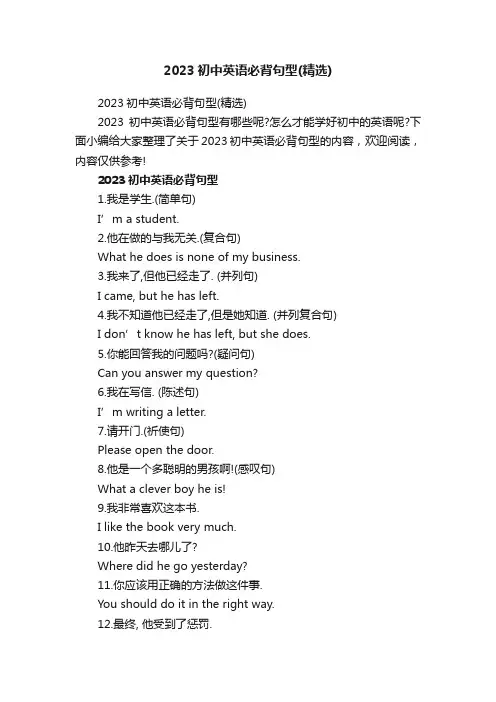
2023初中英语必背句型(精选)2023初中英语必背句型(精选)2023初中英语必背句型有哪些呢?怎么才能学好初中的英语呢?下面小编给大家整理了关于2023初中英语必背句型的内容,欢迎阅读,内容仅供参考!2023初中英语必背句型1.我是学生.(简单句)I’m a student.2.他在做的与我无关.(复合句)What he does is none of my business.3.我来了,但他已经走了. (并列句)I came, but he has left.4.我不知道他已经走了,但是她知道. (并列复合句)I don’t know he has left, but she does.5.你能回答我的问题吗?(疑问句)Can you answer my question?6.我在写信. (陈述句)I’m writing a letter.7.请开门.(祈使句)Please open the door.8.他是一个多聪明的男孩啊!(感叹句)What a clever boy he is!9.我非常喜欢这本书.I like the book very much.10.他昨天去哪儿了?Where did he go yesterday?11.你应该用正确的方法做这件事.You should do it in the right way.12.最终, 他受到了惩罚.At last, he was punished.13.他在湖里游泳.He is swimming in the lake.14.至今,我已经读了100部小说.So far, I have read 100 novels.15.我不喜欢这乐曲.I don’t like the music.16.你喜欢音乐吗?Do you like music?17.如果我是你, 我会跟他在一起.If I were you, I would stay with him.18.面对困难,一定要保持冷静.When facing difficulty, you should keep calm.19.最终,他梦想成真.At last, his dream came true.20.你所说的听起来很有道理.What you says sounds reasonable.初中英语常考句式1. be worth doing值得被……(主动形式表被动含义)The book is well worth reading.这本书很值得被读。

收藏初中英语 50 个必考句型初中英语学习过程中,一些核心句型需要大家一起背,在平时的学习和考试中可以事半功倍。
今天我为大家整理了50个初中英语学习必须背的核心句型。
赶紧背下来!句型 1There+be +主语+地点状语/ 时间状语例句:There's a boat in the river.河里有条船。
句型 2How do you like...?例句:How do you like China?你觉得中国怎么样?句型 3What's wrong with+sb. / sth. ?例句:What's wrong with your watch?你的手表有什么毛病?句型 4What do you like about...?例句:What do you like about China?你喜欢中国的什么?句型 5had better(not)+动词原形例句:You'd better ask that policeman over there.你最好去问问那边的那个警察。
句型 6How+adj. / adv. +主语+谓语!What a/ an+adj. +n. +主语+谓语!例句:How cold it is today!今天多冷啊!What a fine picture it is!多美的一幅图画呀!句型 7Thank+sb. +for(doing)sth.例句:Thank you for ing to see me.感谢你来看我。
句型 8So+be/ 情态动词/ 助动词+主语例句:He is a student. So am I.他是一个学生,我也是。
句型 9... not ... until ...例句:He didn't have supper until his parents came back.直到他的父母回来他才吃饭。
句型 10比较级+and+比较级例句:The baby cried harder and harder.那孩子哭得越来越厉害。
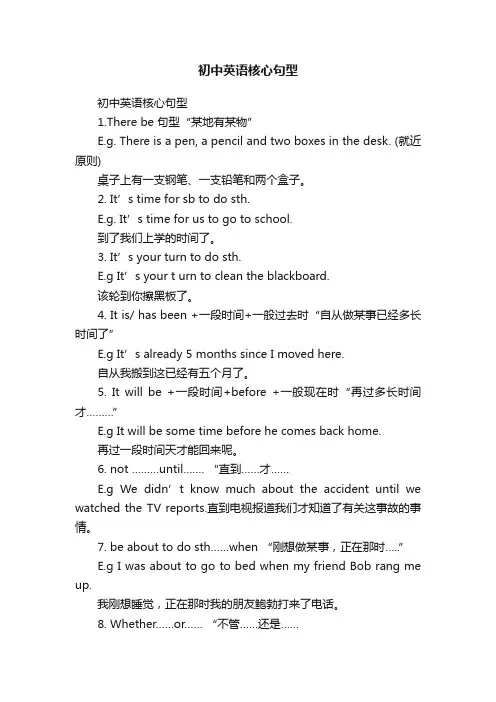
初中英语核心句型初中英语核心句型1.There be 句型“某地有某物”E.g. There is a pen, a pencil and two boxes in the desk. (就近原则)桌子上有一支钢笔、一支铅笔和两个盒子。
2. It’s time for sb to do sth.E.g. It’s time for us to go to school.到了我们上学的时间了。
3. It’s your turn to do sth.E.g It’s your t urn to clean the blackboard.该轮到你擦黑板了。
4. It is/ has been +一段时间+一般过去时“自从做某事已经多长时间了”E.g It’s already 5 months since I moved here.自从我搬到这已经有五个月了。
5. It will be +一段时间+before +一般现在时“再过多长时间才………”E.g It will be some time before he comes back home.再过一段时间天才能回来呢。
6. not ………until……. “直到……才……E.g We didn’t know much about the accident until we watched the TV reports.直到电视报道我们才知道了有关这事故的事情。
7. be about to do sth……when “刚想做某事,正在那时…..”E.g I was about to go to bed when my friend Bob rang me up.我刚想睡觉,正在那时我的朋友鲍勃打来了电话。
8. Whether……or…… “不管……还是……E.g Whether the weather is good or bad, they will set off as they planned.不管天气是好还是坏,他们都会按计划出发。
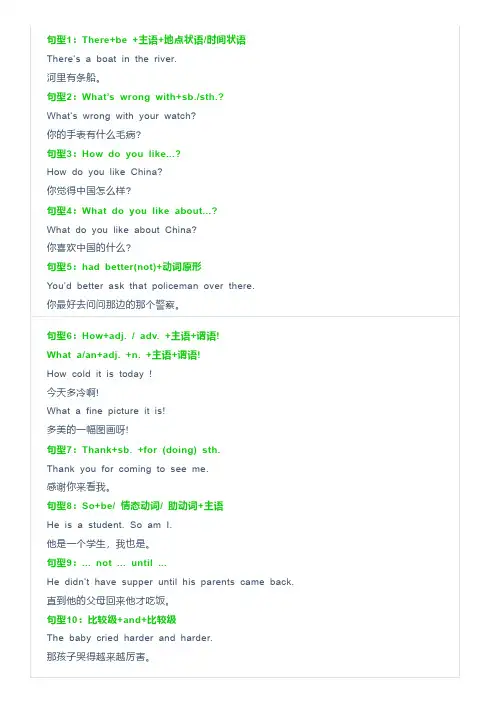
句型1:There+be +主语+地点状语/时间状语 There’s a boat in the river. 河里有条船。
句型2:What’s wrong with+sb./sth.? What’s wrong with your watch? 你的手表有什么毛病? 句型3:How do you like...? How do you like China? 你觉得中国怎么样? 句型4:What do you like about...? What do you like about China?你喜欢中国的什么? 句型5:had better(not)+动词原形 You’d better ask that policeman over there. 你最好去问问那边的那个警察。
句型6:How+adj. / adv. +主语+谓语! What a/an+adj. +n. +主语+谓语! How cold it is today ! 今天多冷啊! What a fine picture it is! 多美的一幅图画呀! 句型7:Thank+sb. +for (doing) sth.Thank you for coming to see me. 感谢你来看我。
句型8:So+be/ 情态动词/ 助动词+主语 He is a student. So am I. 他是一个学生,我也是。
句型9:... not ... until ... He didn’t have supper until his parents came back. 直到他的父母回来他才吃饭。
句型10:比较级+and+比较级 The baby cried harder and harder. 那孩子哭得越来越厉害。
句型11:the +比较级,the +比较级 The more one has,the more one wants. 越有越贪。
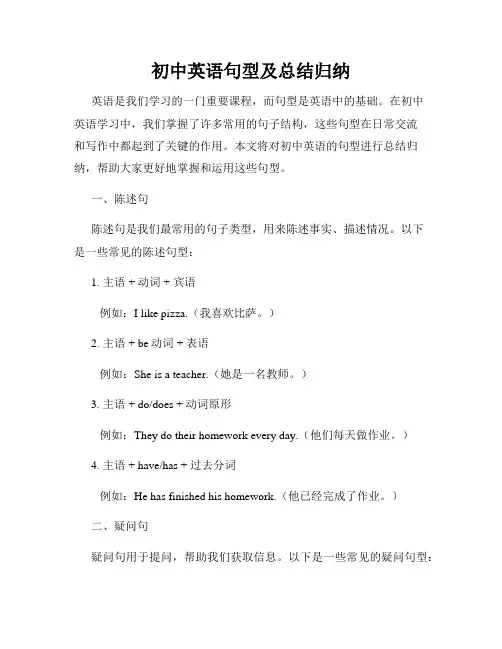
初中英语句型及总结归纳英语是我们学习的一门重要课程,而句型是英语中的基础。
在初中英语学习中,我们掌握了许多常用的句子结构,这些句型在日常交流和写作中都起到了关键的作用。
本文将对初中英语的句型进行总结归纳,帮助大家更好地掌握和运用这些句型。
一、陈述句陈述句是我们最常用的句子类型,用来陈述事实、描述情况。
以下是一些常见的陈述句型:1. 主语 + 动词 + 宾语例如:I like pizza.(我喜欢比萨。
)2. 主语 + be动词 + 表语例如:She is a teacher.(她是一名教师。
)3. 主语 + do/does + 动词原形例如:They do their homework every day.(他们每天做作业。
)4. 主语 + have/has + 过去分词例如:He has finished his homework.(他已经完成了作业。
)二、疑问句疑问句用于提问,帮助我们获取信息。
以下是一些常见的疑问句型:1. 疑问词 + 助动词 + 主语 + 动词?例如:What do you like?(你喜欢什么?)2. 助动词 + 主语 + 动词?例如:Do you play basketball?(你打篮球吗?)3. 特殊疑问句例如:Where did you go yesterday?(你昨天去哪里了?)三、祈使句祈使句用于表达请求、命令或建议。
以下是一些常见的祈使句型:1. 动词原形 + 其他成分例如:Open the window, please.(请打开窗户。
)2. 动词原形 + 不定代词/名词例如:Eat some fruit.(吃些水果。
)四、感叹句感叹句用于表达惊讶、赞美、喜悦等情感。
以下是一些常见的感叹句型:1. How + 形容词/副词 + 主语 + 动词!例如:How beautiful the flowers are!(花儿多美啊!)2. What + 形容词 + 名词 + 主语 + be动词!例如:What a lovely dog he has!(他有一只多可爱的狗啊!)五、条件句条件句用于表达假设、条件和结果之间的关系。
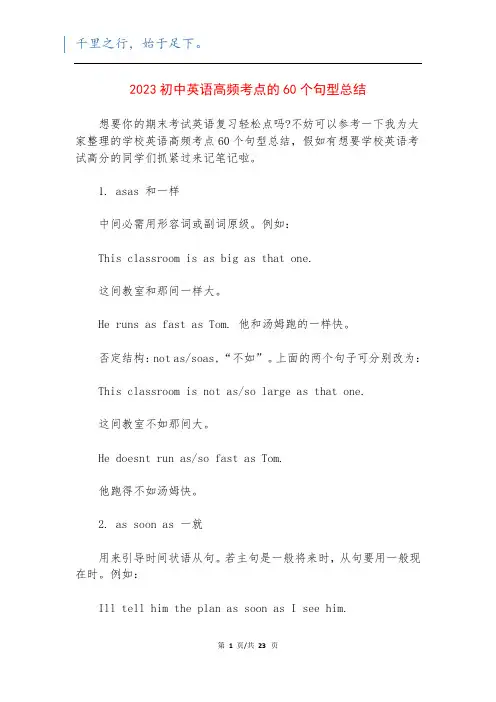
2023初中英语高频考点的60个句型总结想要你的期末考试英语复习轻松点吗?不妨可以参考一下我为大家整理的学校英语高频考点60个句型总结,假如有想要学校英语考试高分的同学们抓紧过来记笔记啦。
1. asas 和一样中间必需用形容词或副词原级。
例如:This classroom is as big as that one.这间教室和那间一样大。
He runs as fast as Tom. 他和汤姆跑的一样快。
否定结构:not as/soas,“不如”。
上面的两个句子可分别改为: This classroom is not as/so large as that one.这间教室不如那间大。
He doesnt run as/so fast as Tom.他跑得不如汤姆快。
2. as soon as 一就用来引导时间状语从句。
若主句是一般将来时,从句要用一般现在时。
例如:Ill tell him the plan as soon as I see him.我一看到他就告知他这个方案。
Hell go home as soon as he finishes his work.他一完成工作就回家。
3. be busy/enjoy/hate/go on/finish doing sth. 忙于/喜爱/厌烦/连续/完成做某事在enjoy, finish, hate, go on, be busy等词语后,一般用动词-ing形式作宾语。
例如:Lin Tao is busy making a model plane.林涛正忙着做飞机模型。
My mother enjoys taking a walk after supper.我妈妈喜爱晚饭后漫步。
I hate watching Channel Five.我厌烦看五频道。
When someone asked him to have a rest, he just went on working.当有人让他休息一会儿时,他仍连续工作。
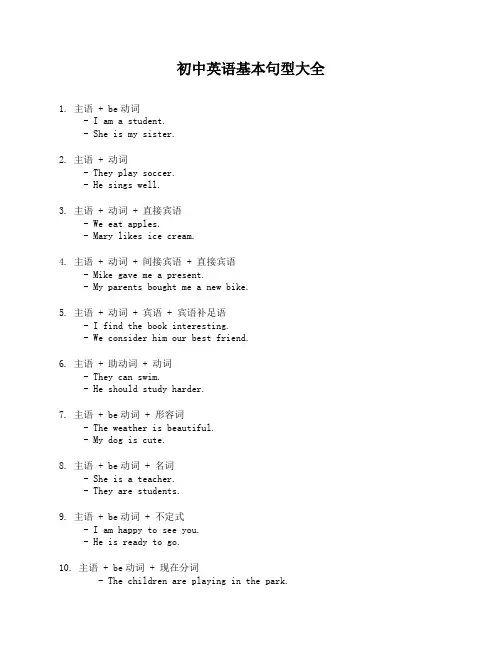
初中英语基本句型大全1. 主语 + be动词- I am a student.- She is my sister.2. 主语 + 动词- They play soccer.- He sings well.3. 主语 + 动词 + 直接宾语- We eat apples.- Mary likes ice cream.4. 主语 + 动词 + 间接宾语 + 直接宾语- Mike gave me a present.- My parents bought me a new bike.5. 主语 + 动词 + 宾语 + 宾语补足语- I find the book interesting.- We consider him our best friend.6. 主语 + 助动词 + 动词- They can swim.- He should study harder.7. 主语 + be动词 + 形容词- The weather is beautiful.- My dog is cute.8. 主语 + be动词 + 名词- She is a teacher.- They are students.9. 主语 + be动词 + 不定式- I am happy to see you.- He is ready to go.10. 主语 + be动词 + 现在分词- The children are playing in the park.- The flowers are blooming beautifully.11. 主语 + be动词 + 过去分词- The house was built last year.- The cake was eaten by the children.12. 主语 + have/has + 过去分词- I have finished my homework.- She has written a letter.13. 主语 + have/has + been + 现在分词- We have been waiting for an hour.- He has been studying all day.14. 主语 + have/has + been + 过去分词- They have been invited to the party.- She has been praised for her hard work.15. 主语 + was/were + 动词的-ing形式- I was reading a book when he called.- They were playing basketball at that time.16. 主语 + 动词不定式- You should listen carefully.- We need to study for the test.17. 主语 + 即将/打算 + 动词原形- I am going to visit my grandparents next week.- They are planning to go on a trip.18. 主语 + can/could + 动词原形- She can swim.- They could speak Chinese when they were young.19. 主语 + must/mustn't + 动词原形- You must finish your homework before you go out.- They mustn't smoke in the building.20. 主语 + may/might + 动词原形- He may come to the party tonight.- It might rain tomorrow.21. 主语 + should + 动词原形- We should help people in need.- You should apologize for your mistake.22. 主语 + would like + to + 动词原形- I would like to go shopping with you.- They would like to eat dinner at the restaurant.23. 介词短语作状语- She went to school by bus.- We played soccer in the park.24. 介词短语作定语- The book on the table is mine.- The girl with long hair is my sister.25. 定语从句- The woman who is wearing a red dress is my mother.- The book that I borrowed from the library is very interesting.26. 状语从句- I will go swimming if it is sunny tomorrow.- She cried because she failed the exam.27. 名词性从句- What he said is true.- I don't know where she lives.28. 并列句- He likes apples, but he doesn't like oranges.- I want to go to the movies, and she wants to stay home.29. 条件句- If it rains, we won't go to the park.- She will buy a new dress if she has enough money.30. 倒装句- Never have I seen such a beautiful sunset.- Not only did he study English, but he also learned French.以上是初中英语基本句型大全,包括了主谓结构、宾语结构、状语结构、从句等等。
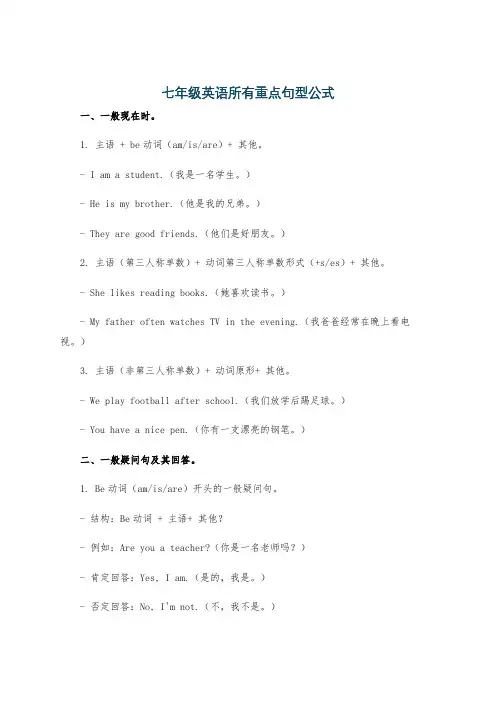
七年级英语所有重点句型公式一、一般现在时。
1. 主语 + be动词(am/is/are)+ 其他。
- I am a student.(我是一名学生。
)- He is my brother.(他是我的兄弟。
)- They are good friends.(他们是好朋友。
)2. 主语(第三人称单数)+ 动词第三人称单数形式(+s/es)+ 其他。
- She likes reading books.(她喜欢读书。
)- My father often watches TV in the evening.(我爸爸经常在晚上看电视。
)3. 主语(非第三人称单数)+ 动词原形+ 其他。
- We play football after school.(我们放学后踢足球。
)- You have a nice pen.(你有一支漂亮的钢笔。
)二、一般疑问句及其回答。
1. Be动词(am/is/are)开头的一般疑问句。
- 结构:Be动词 + 主语+ 其他?- 例如:Are you a teacher?(你是一名老师吗?)- 肯定回答:Yes, I am.(是的,我是。
)- 否定回答:No, I'm not.(不,我不是。
)- Is he at home?(他在家吗?)- 肯定回答:Yes, he is.(是的,他在。
)- 否定回答:No, he isn't.(不,他不在。
)2. 助动词(do/does)开头的一般疑问句(用于行为动词的一般现在时)- 结构:Do/Does+主语+动词原形+其他?- 例如:Do you like music?(你喜欢音乐吗?)- 肯定回答:Yes, I do.(是的,我喜欢。
)- 否定回答:No, I don't.(不,我不喜欢。
)- Does she go to school by bike?(她骑自行车去上学吗?)- 肯定回答:Yes, she does.(是的,她是。
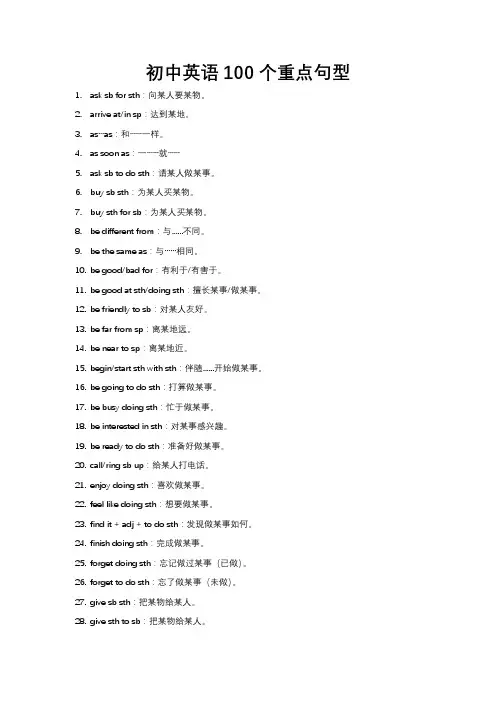
初中英语100个重点句型1.ask sb for sth:向某人要某物。
2.arrive at/in sp:达到某地。
3.as…as:和……一样。
4.as soon as:一……就……5.ask sb to do sth:请某人做某事。
6.buy sb sth:为某人买某物。
7.buy sth for sb:为某人买某物。
8.be different from:与......不同。
9.be the same as:与……相同。
10.be good/bad for:有利于/有害于。
11.be good at sth/doing sth:擅长某事/做某事。
12.be friendly to sb:对某人友好。
13.be far from sp:离某地远。
14.be near to sp:离某地近。
15.begin/start sth with sth:伴随......开始做某事。
16.be going to do sth:打算做某事。
17.be busy doing sth:忙于做某事。
18.be interested in sth:对某事感兴趣。
19.be ready to do sth:准备好做某事。
20.call/ring sb up:给某人打电话。
21.enjoy doing sth:喜欢做某事。
22.feel like doing sth:想要做某事。
23.find it + adj + to do sth:发现做某事如何。
24.finish doing sth:完成做某事。
25.forget doing sth:忘记做过某事(已做)。
26.forget to do sth:忘了做某事(未做)。
27.give sb sth:把某物给某人。
28.give sth to sb:把某物给某人。
29.get to sp:达到某地。
30.go on doing sth:继续做同一件事。
31.go on to do sth:继续做另一件事。
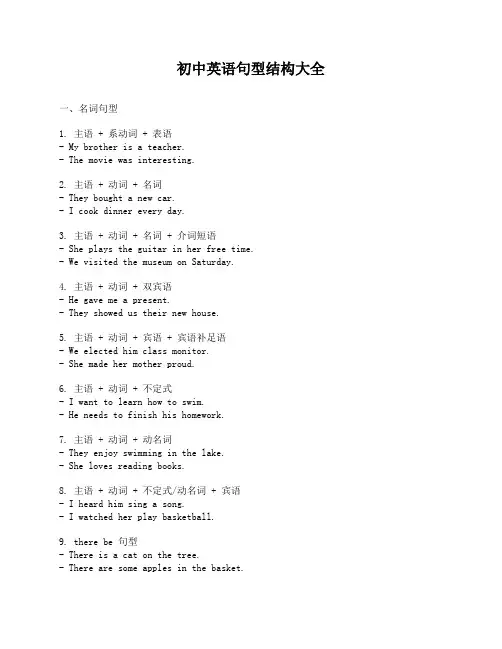
初中英语句型结构大全一、名词句型1. 主语 + 系动词 + 表语- My brother is a teacher.- The movie was interesting.2. 主语 + 动词 + 名词- They bought a new car.- I cook dinner every day.3. 主语 + 动词 + 名词 + 介词短语- She plays the guitar in her free time.- We visited the museum on Saturday.4. 主语 + 动词 + 双宾语- He gave me a present.- They showed us their new house.5. 主语 + 动词 + 宾语 + 宾语补足语- We elected him class monitor.- She made her mother proud.6. 主语 + 动词 + 不定式- I want to learn how to swim.- He needs to finish his homework.7. 主语 + 动词 + 动名词- They enjoy swimming in the lake.- She loves reading books.8. 主语 + 动词 + 不定式/动名词 + 宾语- I heard him sing a song.- I watched her play basketball.9. there be 句型- There is a cat on the tree.- There are some apples in the basket.二、形容词句型1. 主语 + be + 形容词- She is beautiful.- It is cold today.2. 主语 + be + 名词 + 形容词- He is a hardworking student.- They are happy children.3. 主语 + be + 形容词 + 不定式/动名词- The book is interesting to read. - The movie is exciting to watch.4. 主语 + 动词 + 形容词- I find the story very interesting. - We consider it important to study.5. 主语 + 动词 + 名词 + 形容词- They made me feel proud of myself. - She found the movie boring.6. 主语 + 动词 + 形容词 + 宾语- We keep our classroom clean.- He made his sister happy.三、副词句型1. 主语 + 动词 + 副词- He runs fast.- She speaks English fluently.2. 主语 + be + 副词- The weather is really nice.- The food smells delicious.3. 主语 + 动词 + 形容词 + 副词- They sing beautifully.- He plays tennis well.4. 主语 + 动词 + 副词 + 宾语- I eat breakfast early in the morning.- They finished their work quickly.四、介词句型1. 动词 + 介词 + 宾语- She looks at herself in the mirror.- He listens to music every evening.2. 形容词/副词 + 介词 + 宾语- She is afraid of spiders.- The cat jumps onto the table.3. 名词/代词 + 介词 + 名词/代词- I gave the book to him.- She borrowed a pen from me.五、连接词句型1. 并列连词- She is smart and beautiful.- He likes playing basketball but hates swimming.2. 结果连词- She studied hard, so she passed the exam.- He didn't study, therefore he failed the test.3. 条件连词- If it rains tomorrow, we will stay indoors.- Unless you finish your homework, you can't play video games.4. 原因连词- He is tired because he stayed up late last night.- We missed the bus as we woke up late.5. 转折连词- He is nice, but sometimes he can be mean.- I love ice cream; however, I am lactose intolerant.6. 让步连词- Although it was raining, they went hiking.- Despite feeling tired, she continued to work.六、从句句型1. 名词性从句- What she said is true.- Whether he will come or not is uncertain.2. 定语从句- The book that she lent me is very interesting.- The girl who won the race is my friend.3. 状语从句- I will go to the party if I have time.- She cried because she failed the test.以上是初中英语常用的句型结构,包括名词句型、形容词句型、副词句型、介词句型、连接词句型和从句句型。
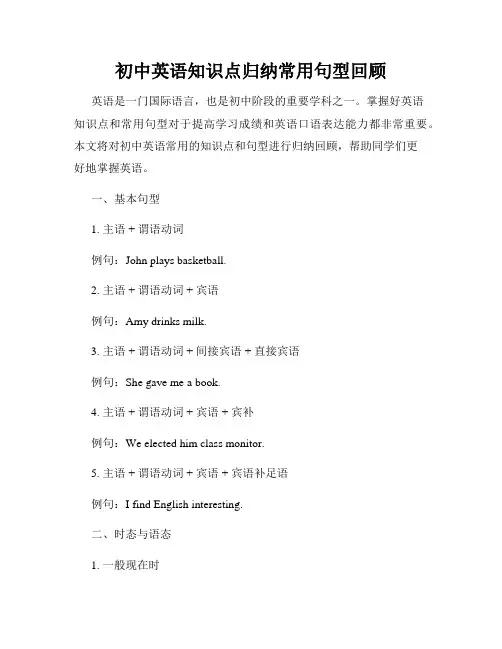
初中英语知识点归纳常用句型回顾英语是一门国际语言,也是初中阶段的重要学科之一。
掌握好英语知识点和常用句型对于提高学习成绩和英语口语表达能力都非常重要。
本文将对初中英语常用的知识点和句型进行归纳回顾,帮助同学们更好地掌握英语。
一、基本句型1. 主语 + 谓语动词例句:John plays basketball.2. 主语 + 谓语动词 + 宾语例句:Amy drinks milk.3. 主语 + 谓语动词 + 间接宾语 + 直接宾语例句:She gave me a book.4. 主语 + 谓语动词 + 宾语 + 宾补例句:We elected him class monitor.5. 主语 + 谓语动词 + 宾语 + 宾语补足语例句:I find English interesting.二、时态与语态1. 一般现在时例句:They always go to school by bus.2. 一般过去时例句:She studied hard last night.3. 一般将来时例句:I will visit my grandparents next week.4. 现在进行时例句:He is playing soccer now.5. 现在完成时例句:We have already finished our homework. 6. 被动语态例句:The window was broken by the strong wind.三、疑问句及回答1. 一般疑问句例句:Do you like ice cream?回答:Yes, I do. / No, I don't.2. 特殊疑问句例句:What is your favorite color?回答:My favorite color is blue.3. 反意疑问句例句:You like English, don't you?回答:Yes, I do. / No, I don't.四、比较句型1. 比较级例句:She is taller than her sister.2. 最高级例句:This is the best book I have ever read.五、祈使句和感叹句1. 祈使句例句:Please close the door.注意:祈使句的主语通常省略。
初中英语62个必背核心句型a boat in the river、河里有条船。
句型2:What’s wrong with+sb、 / sth、?What’s wrong with your watch?你的手表有什么毛病?句型3:How do you like、、、?How do you like China?你觉得中国怎么样?句型4:What do you like about、、、?What do you like about China?你喜欢中国的什么?句型5:had better(not)+动词原形You’d better ask that policeman over there、你最好去问问那边的那个警察。
句型6:How+adj、 / adv、 +主语+谓语! What a/an+adj、 +n、 +主语+谓语! How cold it is today !今天多冷啊!What a finepicture it is!多美的一幅图画呀!句型7:Thank+sb、 +for (doing)sth、Thank you for coming to see me、感谢你来看我。
句型8:So+be/ 情态动词/ 助动词+主语He is a student、 So am I、他是一个学生,我也是。
句型9:、、、 not 、、、until 、、、He didn’t have supper until his parents came back、直到他的父母回来他才吃饭。
句型10:比较级+and+比较级The baby cried harder and harder、那孩子哭得越来越厉害。
句型11:the +比较级,the +比较级The more one has,the more one wants、越有越贪。
句型12:、、、 as +adj、/ adv、+as 、、、…not as/so+adj/adv、 +as、、、 Do you thinkthat art is as important as music?你认为艺术和音乐一样重要吗?Last Sunday the weather was not so wet as it is today、上个星期天的天气不如今天的天气潮湿。
初中英语重点句型归纳一、陈述句型1. 主语 + be动词 + 表语例句:I am a student.2. 主语 + 动词 + 宾语例句:Tom likes playing basketball.3. 主语 + 动词 + 间接宾语 + 直接宾语例句:My mother bought me a new book.4. 主语 + 动词 + 宾语 + 宾语补足语例句:We elected him monitor.5. 主语 + 动词 + 宾语 + 宾语补足语 + 宾语补足语例句:They made him chairman.6. 主语 + do/does + not + 动词原形例句:She does not like swimming.7. Do/Does + 主语 + 动词原形例句:Do you like English?8. 主语 + have/has + 过去分词例句:He has finished his homework.9. 主语 + have/has + not + 过去分词例句:They haven't seen the film yet.10. Have/Has + 主语 + 过去分词例句:Have you ever visited Beijing?11. There be句型例句:There is a book on the desk.12. It be + adj. + 不定式例句:It is important to learn English well.13. It is + adj. + for + 人 + to + 不定式例句:It is difficult for me to solve the math problem.二、疑问句型1. Yes/No问句:句型为:Do/Does + 主语 + 动词原形?例句:Do you like English?2. 特殊疑问句:以特殊疑问词(what, where, when, why, who, how等)开头。
中考英语重点句型归纳**中考英语重点句型归纳**1. “It's + adj. + (for sb.) to do sth.”这个句型超级重要哦。
它的意思就是“(对某人来说)做某事是……的”。
比如说,“It's difficult for me to learn English well.”(对我来说学好英语是困难的)。
就像爬山,山很高,要爬到山顶不容易,学好英语就像爬这座高山一样,这个句型就很好地表达出这种感觉。
你难道不觉得这个句型很实用吗?2. “too...to...”结构。
意思是“太……而不能……”。
例如,“He is too young to go to school.”(他太小了以至于不能去上学)。
这就好比一个小杯子,想装一大桶水,根本装不下嘛。
你想啊,如果不掌握这个句型,很多类似这样表达“能力不足”的情况就很难准确说出来,多可惜呀!3. “not...until...”,“直到……才……”。
像这个句子“I didn't go to bed until my mother came back.”(直到我妈妈回来我才上床睡觉)。
这就像在等待一个信号,信号不来,就一直等,就像在车站等一辆很重要的车,车不来就不能出发一样。
你在生活中肯定也有很多这样等待的情况,这个句型能很好地描述呢。
4. “both...and...”,表示“两者都……”。
比如“Both Tom and Jerry like ice cream.”(汤姆和杰瑞都喜欢冰淇淋)。
这就像两个好朋友,他们有着共同的喜好,只要一提到冰淇淋,两个人都会眼睛放光。
如果描述两个人或者两件事物有相同的情况,这个句型就派上大用场了。
5. “either...or...”,“要么……要么……”。
例如,“You can either come wit h me or stay here.”(你要么跟我来,要么就呆在这儿)。
七年级英语句型归纳一、陈述句型1. 主语+谓语+宾语:这是最基本的人称句型,也是英语中最常用的句型。
在这个句型中,主语通常是动作的执行者或承受者,而谓语则描述了动作或状态,宾语则是动作的直接对象。
例如:I have a new book. (我有一本新书。
)2. 主语+谓语:这种句型中只有主谓两个部分,通常用来描述一个事实或情况。
例如:The sun rises in the east. (太阳从东方升起。
)二、疑问句型1. 疑问词+主语+谓语:这种句型用于提出一个疑问或询问某件事情。
疑问词通常是指那些可以用来提问的词语,如what, who, where, when等。
例如:Where did you go yesterday? (你昨天去了哪里?)2. 特殊疑问句:这种句型是在疑问词的基础上加上助动词do的形式构成的。
它通常用来询问某事物的具体情况或状态。
例如:How much money do you earn per month? (你每月赚多少钱?)三、祈使句型1. 动词原形+宾语+其他成分:这种句型用于发出一个命令或请求。
它通常以动词原形开头,后面接上宾语和其他成分。
例如:Please pass me the book. (请把书递给我。
)2. Let祈使句:这种句型通常使用let这个动词来构成祈使句。
它通常用于建议或邀请某人做某事。
例如:Let's go for a walk. (我们一起去散步吧。
)四、感叹句型这种句型用于表达强烈的情感或感叹。
它通常由what或how引导,后面跟主语和谓语。
例如:What a beautiful day it is! (多么美好的一天啊!) / How fast he runs! (他跑得多快啊!)五、there be句型这个句型用于描述存在的情况或描述周围环境。
它通常用来表示某地有某物或某人。
例如:There is a book on the table. (桌子上有本书。
七年级英语句型一、一般现在时句型。
1. 肯定句。
- 主语 + be (am/is/are)+ 表语。
- I am a student.(我是一名学生。
)- He is my brother.(他是我的兄弟。
)- They are my friends.(他们是我的朋友。
)- 主语(第三人称单数除外)+ 动词原形+ 其他。
- I like apples.(我喜欢苹果。
)- They play football on Sundays.(他们在星期天踢足球。
)- 主语(第三人称单数)+ 动词第三人称单数形式 (v - s/es)+ 其他。
- He likes reading books.(他喜欢读书。
)- She goes to school by bike.(她骑自行车去上学。
)2. 否定句。
- 主语 + be (am/is/are)+ not+ 表语。
- I am not a teacher.(我不是一名教师。
)- He is not at home.(他不在家。
)- 主语(第三人称单数除外)+ don't + 动词原形+ 其他。
- I don't like bananas.(我不喜欢香蕉。
)- They don't play basketball.(他们不打篮球。
)- 主语(第三人称单数)+ doesn't+ 动词原形+ 其他。
- He doesn't watch TV in the morning.(他早上不看电视。
)3. 一般疑问句。
- Be (am/is/are)+ 主语+ 表语?- Are you a doctor?(你是一名医生吗?)- Is he your father?(他是你的父亲吗?)- (第三人称单数除外)Do + 主语+ 动词原形+ 其他?- Do you like music?(你喜欢音乐吗?)- Do they go to school on foot?(他们步行去上学吗?)- (第三人称单数)Does+ 主语+ 动词原形+ 其他?- Does she like dancing?(她喜欢跳舞吗?)二、一般过去时句型。
2024-2025学年七年级上期中考点大串讲(新人教版)专题01 重点短语、句型归纳Starter Unit 1 Hello !1.starter unit 过渡单元2.good morning 早上好3.sit down坐下4.say hi to sb. 向某人问好5.thank you=thanks 谢谢6.each other 互相;彼此7.my name我的名字8.start a conversation 开始一场谈话9.spell your name拼写你的名字 10.call me Emma叫我Emma 11.go to class去上课12.Let’s do sth. 咱们做某事吧。
13.It’s time for sth.是做某事的时候了。
1.How do you greet people? 你怎样问候别人?2.Sit down, please. 请坐3.Can you say hi to the class? 你能和同学们问好么?4.—What’s your name? 你叫什么名字? —My name is.../I’m... 我叫...。
5.—Nice to meet you. 很高兴认识你。
—Nice to meet you,too. 我也很高兴认识你。
6.—How are you? 你好吗?—I’m fine/great, thanks. 我很好,谢谢。
7.May I have your name? 我能知道你的名字吗? 8. How do you spell your name? 你的名字怎么拼写? 9.You can call me Emma. 你可以叫我埃玛。
10.That’s the bell. 铃声响了。
11.It’s time for class. 该上课了。
12.Let’s go to class. 咱们去上课吧。
1.keep tidy 保持整洁2.in your schoolbag 在你的书包里3.an eraser 一块橡皮4.what colour什么颜色5.black and orange 橙黑相间的6.Peter’s shoes彼得的鞋子7.on the desk 在书桌上8.in the box 在盒子里9.under the bed 在床下 10.a pair of socks 一双袜子 11.need to do sth.需要做某事12.keep your room tidy 保持你房间的整洁 13.wait a minute等一下14.on her dad’s head 在她爸爸的头上1.—What do you have in your schoolbag? 你的书包里面有什么? —I have an eraser. 我有一块橡皮。